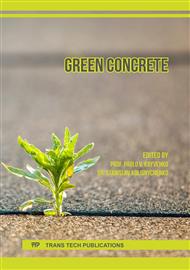p.230
p.239
p.250
p.259
p.272
p.285
p.297
p.309
p.321
High Performance Concrete for Environmentally Efficient Building Structures
Abstract:
Concrete is the most used man made material nowadays. The environmental impact associated with cement production is very significant due to the extent of concrete use. At the same moment cement production is associated with large energy consumption and high amount of greenhouse gas emissions. Development of concrete technology during last twenty years has lead to a significant quality shift of technical parameters and also of related environmental impacts. New types of optimized concrete mixes have significantly improved characteristics from the perspective of strength, mechanical resistance, durability and resistance to extreme loads. The use of alternative non-steel reinforcement from various types of fibres can increase reliability, durability and reduction of environmental impacts. Due to optimization of production technology, concrete is gradually becoming a building material appropriate and advantageous for sustainable construction of buildings. In this context increase of reliability and durability within whole life cycle is essential. New approaches in concrete technology like utilization of high performance and ultra high performance concretes, use of textile reinforcement, shape optimization and conceptual approach for integrated life-cycle assessment of concrete structures are presented in the paper. Some of principles are demonstrated on results of experimental research performed by author and his team at the Czech Technical University in Prague (CTU).
Info:
Periodical:
Pages:
272-284
Citation:
Online since:
May 2016
Authors:
Price:
Сopyright:
© 2016 Trans Tech Publications Ltd. All Rights Reserved
Share:
Citation:



